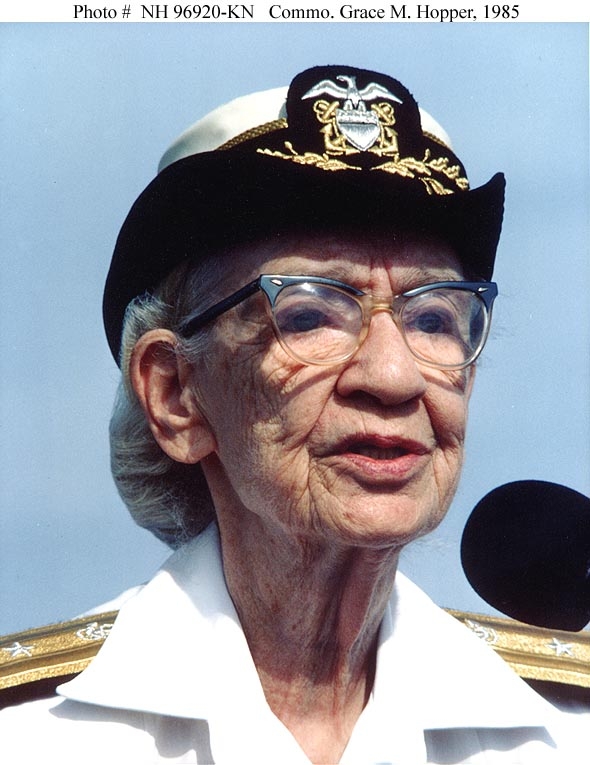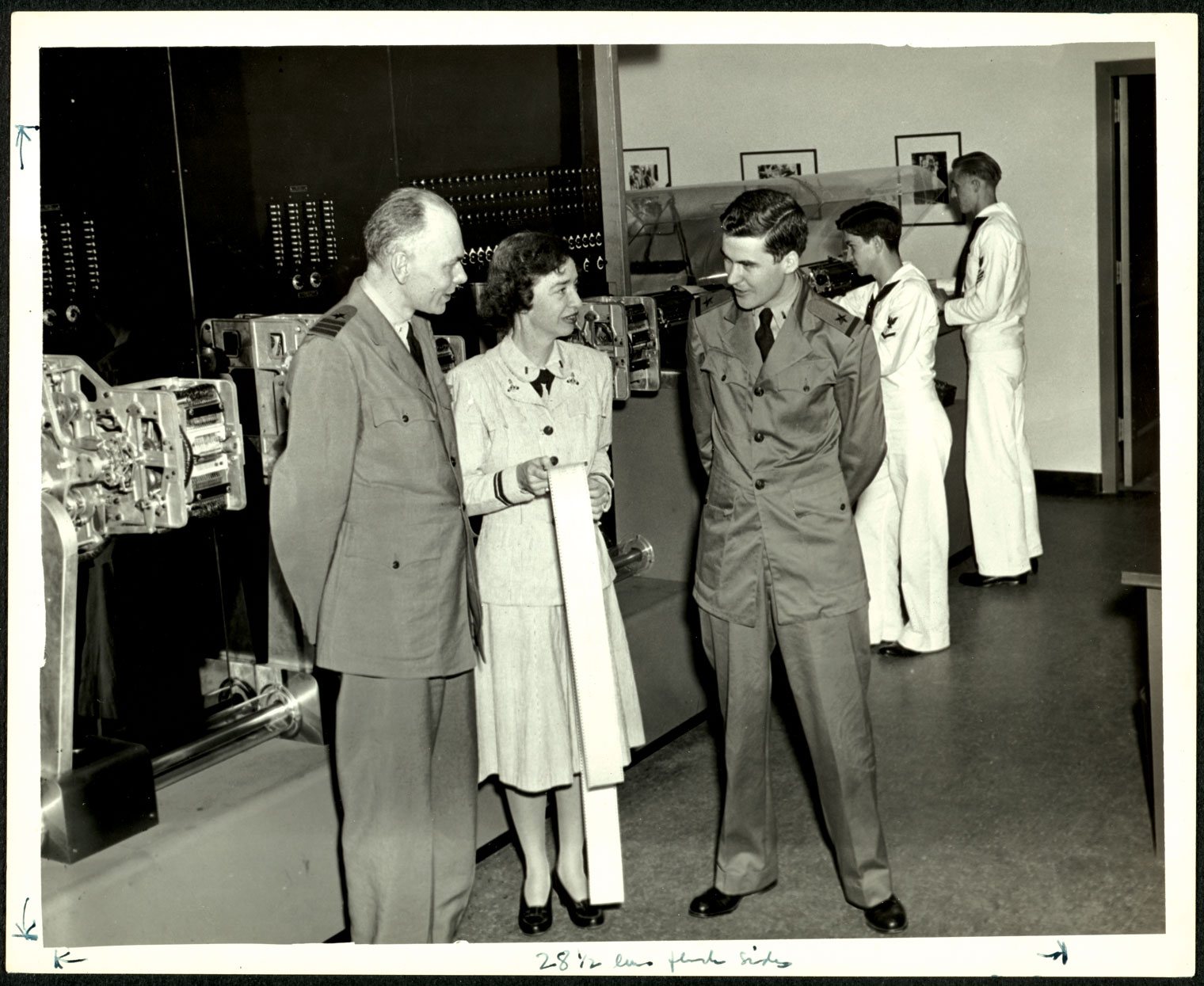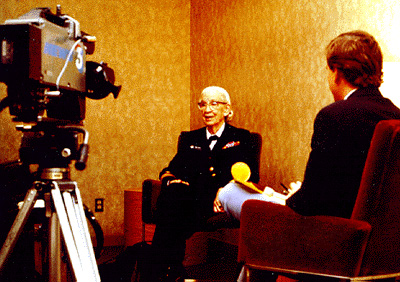 Rear Admiral Grace Hopper (1906 - 1992) was a pioneer in the field of computer science. She was one of the first programmers of the Harvard Mark I computer, and developed the first compiler for a computer programming language. She conceptualized the idea of machine-independent programming languages, which led to the development of COBOL (an acronym for COmmon Business- Oriented Language) one of the first modern programming languages, earning her the nickname “Grandma COBOL.”
Rear Admiral Grace Hopper (1906 - 1992) was a pioneer in the field of computer science. She was one of the first programmers of the Harvard Mark I computer, and developed the first compiler for a computer programming language. She conceptualized the idea of machine-independent programming languages, which led to the development of COBOL (an acronym for COmmon Business- Oriented Language) one of the first modern programming languages, earning her the nickname “Grandma COBOL.”
In 1943, Hopper obtained a leave of absence from college and was sworn in to the United States Navy Reserve, one of many women to volunteer to serve in the WAVES, a World War II division of the U.S. Navy that consisted entirely of women. The name of this group is an acronym for “Women Accepted for Volunteer Emergency Service” (as well as an allusion to ocean waves); the word “emergency” implied that the acceptance of women was due to the unusual circumstances of the war and that at the end of the war the women would not be allowed to continue in Navy careers.
Hopper reported in December of 1943, and trained at the Naval Reserve Midshipmen’s School at Smith College in Northampton, Massachusetts. In 1944, she graduated first in her class, and was assigned to the Bureau of Ships Computations Project at Harvard University as a Lieutenant. She served on the Mark I computer programming staff headed by Howard H. Aiken. Hopper and Aiken coauthored three papers on the Mark I, II, and III, also known as the Automatic Sequence Controlled Calculator.
At the end of the war, Hopper requested to be transferred to the regular Navy, but was declined due to her age. She continued to serve in the United States Navy Reserve, and remained at the Harvard Computation Lab until 1949, turning down a full professorship at Vasser in favor of working as a research fellow under a Navy contract at Harvard.
- Grace Brewster Murray (named after her mother’s best friend, Grace Brewster) was born in New York City on December 9, 1906, the oldest of three children.
- She spent childhood summers at their family cottage on Lake Wentworth in Wolfeboro, New Hampshire, playing kick-the-can, hide-and-seek, and cops-and-robbers with her brother, sister, and cousins.
- In 1930, she married New York University professor Vincent Foster Hopper. They divorced in 1945, but she kept his surname.
- She had to get an exemption to enlist, as she was 15 pounds below the Navy minimum weight of 120 pounds.
- Because of the breadth of her accomplishments and her naval rank, she earned the nickname “Amazing Grace.”
- She popularized the term “debugging” for fixing computer glitches, inspired while witnessing her associates remove a moth that was stuck in a relay and impending operation from a Mark II Computer at Harvard University in 1947.
- The famous quotation “It’s easier to ask forgiveness than it is to get permission” if often attributed to her.
- At the moment of her retirement in 1986, she was the oldest commissioned officer in the United States Navy at 79 years old.
- She died in 1992, and was laid to rest with full military honors in Arlington National Cemetery.
In 1949, Hopper became an employee of the Eckert-Mauchly Computer Corporation, later becoming the Remington Rand Corporation, as a senior mathematician and joined the team developing the UNIVAC I (UNIVersal Automatic Computer I), the first commercial computer produced in the United States. During this time, she conducted work on her original compiler, known as A compiler. In 1954, Hopper was named the company’s first Director of Automatic Programming, and her department released some of the first compiler-based programming languages, including ARITH-MATIC, MATH-MATIC, and FLOW-MATIC.
 In the spring of 1959, a two-day conference known as CODASYL (acronym for “Conference on Data Systems Languages”), a consortium of computer experts from industry and government. Hopper served as the technical consultant to the committee that defined the new language, COBOL. The new language extended Hopper’s FLOW-MATIC language with some ideas from the IBM equivalent, COMTRAN. Hopper’s belief that programs should be written in a language that was close to English rather than in machine code or languages close to machine code (such as assembly language) was captured in the new business language, and COBOL would go on to be the most ubiquitous business language to date.
In the spring of 1959, a two-day conference known as CODASYL (acronym for “Conference on Data Systems Languages”), a consortium of computer experts from industry and government. Hopper served as the technical consultant to the committee that defined the new language, COBOL. The new language extended Hopper’s FLOW-MATIC language with some ideas from the IBM equivalent, COMTRAN. Hopper’s belief that programs should be written in a language that was close to English rather than in machine code or languages close to machine code (such as assembly language) was captured in the new business language, and COBOL would go on to be the most ubiquitous business language to date.
Hopper retired from the Naval Reserve with the rank of Commander at the end of 1966, but was recalled to active duty in August 1967 for a six-month period that turned into an indefinite assignment. She again retired in 1971, but was again asked to return to active duty in 1972. She was promoted to Captain in 1973 by Admiral Elmo R. Zumwalt, Jr.
From 1967 to 1977, Hopper served as the Director of the Navy Programming Languages Group in the Navy’s Office of Information Systems Planning. She developed validation software for the programming language of COBOL and its compiler as part of a COBOL standardization program for the entire United States Navy.
In the 1970s, Hopper pioneered the implementation of standards for testing computer systems and components for early programming languages such as FORTRAN and COBOL. The Navy tests for conformance to these standards led to significant convergence among the programming language dialects of the major computer vendors. In the 1980s, these tests, and their official administration were assumed by the National Bureau of Standards (NBS), known today as the National Institute of Standards and Technology (NIST).
 Hopper is also known as a very lively public speaker, often using visual aids during her lectures. When generals and admirals asked her why satellite communication took so long, she salvaged an obsolete Bell System 25 pair telephone cable and cut it into 11.8 inch-long pieces, which is the distance that light travels in one nanosecond, to illustrate this. Later, she used the same pieces of wire to illustrate why computers had to be small to be fast. At many of her talks, she handed out “nanoseconds” to everyone in the audience, contrasting them with a coil of wire nearly a thousand feet long, representing a microsecond, and even passing out packets of pepper, which she called picoseconds.
Hopper is also known as a very lively public speaker, often using visual aids during her lectures. When generals and admirals asked her why satellite communication took so long, she salvaged an obsolete Bell System 25 pair telephone cable and cut it into 11.8 inch-long pieces, which is the distance that light travels in one nanosecond, to illustrate this. Later, she used the same pieces of wire to illustrate why computers had to be small to be fast. At many of her talks, she handed out “nanoseconds” to everyone in the audience, contrasting them with a coil of wire nearly a thousand feet long, representing a microsecond, and even passing out packets of pepper, which she called picoseconds.
After Rep. Philip Crane of Illinois saw her on a Mach 1983 segment of “60 Minutes,” he championed HR 341, a joint resolution in the House of Representatives, which led to her promotion to Commodore by special Presidential appointment. In 1985, the rank of Commodore was renamed Rear Admiral, and Hopper retired from the Navy with this rank on August 14, 1986. At a celebration held in Boston on the USS Constitution to commemorate her retirement, Hopper was awarded the Defense Distinguished Service Medal, the highest non-combat award possible by the Department of Defense. The USS Hopper, launched in 1996, is on a very short list of military vessels named after women.
Additional Resources